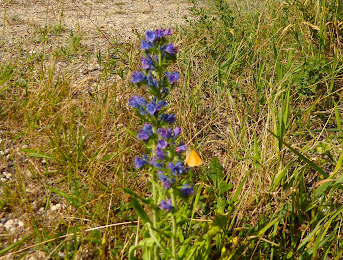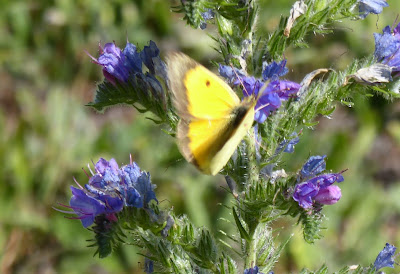Quite a bit has happened over the past week!
I've had my eye on a brownfield site near the Metro Centre that has a fair spread of bird's food trefoil. So I thought it might be a possible for Common Blue or Dingy Skipper and took a look last Friday.
Tramping through the brambles and various forms of litter I saw neither but what did turn up was three or four small heath - the first I have seen this year. I checked back briefly the day after and they were still about.
 |
| Small Heath |
Giving up the idea of more sightings I decided to try out a cycle route to the town centre I've never used. But a bit beyond Dunston on Teams Road I stopped to watch a red admiral I thought might be ovipositing on nettles. Lo and behold what should then fly over the road side habitation but a common blue. I saw about four of them and a brown butterfly that proved to be a large skipper - both first sightings for this year as well:
 | | Common Blue |
|  | | Large Skipper |
|
It just shows that urban environments can too easily be overlooked.
One thing that I haven't seen since I moved to the North East has been any kind of fritillary. So on Monday I decided to return to one of my old haunts - Mabie Forest near Dumfries to see if I could find any there.
It wasn't the most brilliant day with reduced temperatures and only intermittent sunshine so I was relieved when my first sighting came along - perhaps unsurprisingly another small blue, There was four overall, as at Dunston all males. And even better I actually managed to spot the first pearl-bordered fritillary before even reaching the known 'butterfly hotspot.'
 | | Common Blue |
|  | | Pearl-bordered Fritillary |
|
This is the time of the year when pearl-bordered and small pearl-bordered fritillary flight seasons overlap and there are identification issues. Several were only seen in flight making proper identification impossible but one among the ones I photographed and one seen in flight were heavily worn suggesting pearl-bordered, indicating they were definitely in preponderance.
There was however one possibility that I had overlooked and as a result initially misidentified:
 |
| Dark Green Fritillary |
What surprised me here was that I associate them with late rather than early summer at Mabie. However from a total of nine it may be they accounted for some of the ones flying past, notably those strong on the wing.
I was also surprised by the number of dragonflies that were about right at the beginning of June: Hopefully I've got them right.
 | | Common Blue Damselfly |
|  | | Emperor Dragonfly |
|
There were also a couple of moths:
 | | Brown Silverline |
|  | | Cinnebar Moth |
|
There were perhaps 10 of the brown silverline on the day. The only other time I have seen cinnebar moths was I think at Dumfries station.
There were also a couple of mysteries which had me facebooking the experts:
 | | Blotched-winged Whitebelt |
|  | | Tibula Scripta |
|
I have a separate photo that proves the white belt bit on the first one. The other one is a cranefly, and craneflies are a notoriously tricky area. The wings of tibula scripta are transparent in the photos I've seen so I suspect they may be giving an image of the background leaf.
Other butterflies seen were green-veined white and four speckled wood, which I mention because they were not much present in Dumfries and Galloway when I lived there.
On leaving the 'butterfly hotspot' I still hadn't spotted a small pearl-bordered fritillary and was beginning to speculate that, as the more common species, their development had been held back by the dry weather.
However, just over halfway back to the car park one turned up in a clearing where two paths meet:
 |
| Small Pearl-Bordered fritillary |
A bit of luck always enters into it!
Meanwhile there has also been activity in the garden.
A few days ago I was very pleased to see a couple of goldfinches plundering the seed in one of my pots that has been invaded by forget-me-nots. I've never seen them in the garden before. Also the bullfinches continue to enjoy the sunflower hearts from the feeder.
Another near misidentification (which has been a bit of a theme lately) but I've also been getting visits from patchwork leafcutter bees of both genders.
 | | Bullfinch |
|  | | Patchwork Leafcutter Bee |
|























































